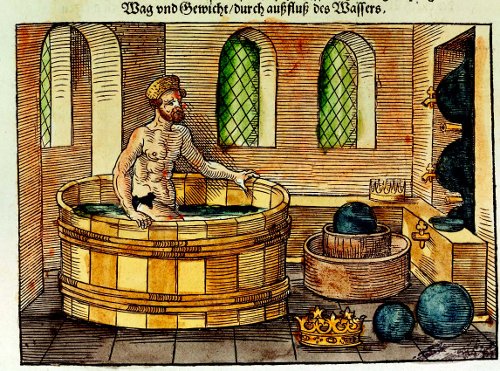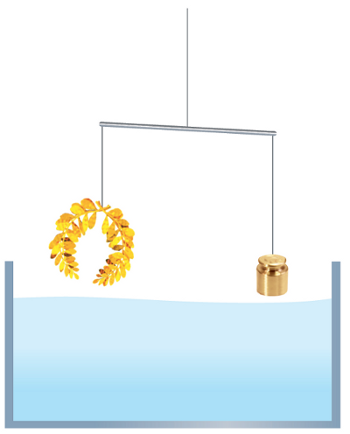Archimedes of Syracuse and the Golden Crown
Archimedes, the ancient Greek physicist, will always be linked to this famous story.
The Roman architect Vitruvius tells us that Archimedes started to study buoyancy because of the king of Syracuse, Hiero II. The king asked him to determine whether a crown was made of gold or of other metals.
Archimedes discovered how to solve the problem while he was in the bath. He noticed that the water level rose when he got into the bath. He was so happy about his discovery that he ran into the streets of Syracuse shouting “ευ῞ρηκα” (héureka, “I’ve found it”).
Vitruvius says that Archimedes then solved the problem by measuring the volume of the crown and of a piece of gold of the same weight. He determined their volumes by putting them in a container full of water and measuring the quantity of water that overflowed.
However, this is not very plausible for two reasons. Firstly, the error is too large. Secondly, it does not involve the theory of buoyancy that Archimedes developed.
A more reliable version of the story says that Archimedes placed the crown and a piece of gold, of the same weight, on a balance and put it in water. If the crown was pure gold, the balance would remain in equilibrium. If the balance went down on the side of the piece of gold, this means that the crown was subjected to a higher buoyancy force than the piece of gold, because they were of the same weight. So, the crown had a higher volume. This implies that the crown had a lower density than the gold and that it was made from other, lower density materials, like silver.

Hand-coloured woodcut from 1547 of Greek mathematician and inventor Archimedes.

Archimedes solved the problem of the crown by measuring buoyancy.
Minidictionary
Buoyancy = Galleggiamento
Crown = Corona
To float = Galleggiare
To go down = Abbassarsi
To overflow = Traboccare
Reliable = Attendibile
To rise = Alzarsi

